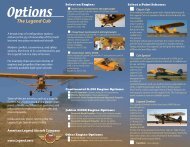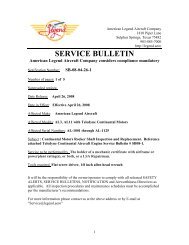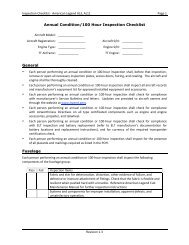Lycoming Flyer - Aircrafts sales, engines repair, spare parts
Lycoming Flyer - Aircrafts sales, engines repair, spare parts
Lycoming Flyer - Aircrafts sales, engines repair, spare parts
- No tags were found...
Create successful ePaper yourself
Turn your PDF publications into a flip-book with our unique Google optimized e-Paper software.
The mathematics to arrive at this fuel usage are simple:180 HP X 75% of power = 135 HP135 HP X .435 BSFC = 58.7 lbs. of fuel58.7 lbs. of fuel 6 lbs. per gal. = 9.8 gal. per hourHaving made some assessments about what can happen with astandard propeller, now we will try to see what happens whena cruise propeller is installed in place of the original. The firstthing we must know about the cruise propeller is that it has morepitch than the standard propeller. This means it will take a bigger“bite” of air than the original propeller with each revolution. Thisbigger bite of air will have an effect on aircraft performance andon how the engine may be operated.Taking a bigger bite of air increases the resistance to the turningpropeller. Perhaps it may be easiest to imagine what happensby considering your hand when held in the airstream outsidea moving automobile with the palm forward as compared tohaving the side of the hand forward. Because of this increasedresistance, the static RPM will be lower than with the originalpropeller. The same thing will be true when full throttle, inflightRPM, is compared to that of the standard propeller at asimilar altitude and temperature. This will reduce takeoff performanceof any aircraft. Using the earlier example, the enginewas rated at 180 horsepower at full throttle and 2700 RPM.Now, in spite of applying full throttle, the increased resistancereduces the maximum attainable RPM to something less than2700. As a result of not developing the rated 2700 RPM, theengine also will not develop the power for which it was rated.Since maximum power is less than full rated, aircraft performancewill suffer. This should be considered before a fixedpitchpropeller is chosen or exchanged for a different model.At this point, we must return to the original question. Whydoes the engine require more fuel with the cruise propeller?It is an accepted fact that the cruise propeller is more efficientfor cruise operation, so it would not be unusual to follow thisline of thinking. Seventy-five percent of rated power, usingthe original propeller at sea level and standard temperature,required a throttle setting to achieve 2450 RPM. Therefore,without more thoughtful consideration, it seems logical thatthe cruise propeller might also be set for 2450 RPM when75% power is desired. Of course, there is an increase in performance,but this can be attributed to the more efficientcruise propeller. Next comes the realization that the improvedcruise performance isn’t all efficiency. Instead of 9.8 gallonsof fuel, the engine is now using a greater amount of fuel perhour. For purposes of this illustration, let us assume that thenumber is 11 GPH. By reversing the mathematics used earlier,it is possible to estimate the horsepower and percentage ofpower actually being used as a result of operating the cruiseprop at 2450 RPM with a best economy fuel/air mixture.11 GPH X 6 lbs. per gallon = 66 pounds66 pounds .435 BSFC = 151.7 horsepower151.7 HP 180 rated HP = 84.3% of powerAssuming a fuel usage of 11 gallons per hour for this problemprovides a reasonably realistic example of the change that adifferent fixed-pitch propeller might create. It also illustratesthe need for pilots to change their habits when a propeller ischanged. In addition to the change of habits, the discussionshows a real need to reevaluate the takeoff, climb and cruiseperformance of an aircraft if the fixed-pitch propeller ischanged for a different model.Another very important point concerns leaning. Remember that<strong>Lycoming</strong> recommends leaning to best economy only at 75% ofrated horsepower or less. It is very possible that leaning to roughnessor to peak on the EGT gage could cause serious damage if theengine is actually producing more than 75% of rated horsepoweras shown in this illustration.With this information as background, it is easy to see that settinga desired power with a fixed-pitch propeller can only beaccomplished if the pilot has a chart that applies to the specificaircraft/engine/propeller combination. Although the power chartfor a new aircraft may come from data obtained by test flyingwith a calibrated torque meter, a fairly accurate chart can bederived for any fixed-pitch propeller and engine combination.Briefly, this is done by finding the maximum available RPMat any particular altitude and applying data from the propellerload curve.To conclude, the purpose of this article is to make readers moreaware of some operational aspects of the fixed-pitch propeller.Usually, it is only necessary to accept the material providedby the airframe manufacturer and to use the engine/propelleras directed. If a propeller change is made, or on those rareoccasions when we question the power available to the propeller,the material presented here could prove to be helpful.From time to time, a field-service report states that an engine hasdamage. After further examination of the engine, this damagemay be classified as “induced damage.” To clarify what is meantby this term, induced engine damage is a failure or unsatisfactorycondition which results from operational or maintenance practicesemployed after the engine is placed in service. Although there area variety of conditions which may fall into the induced damagecategory, this article will discuss two particular types of failureand the circumstances which can induce them.Examination of an engine that is reported to have low compression,loss of power, erratic operation, metal contamination oreven complete engine stoppage may result in a determinationthat pistons are burned or valves stretched. (Stretched valves aresometimes said to be tuliped.) These two types of damage canbe initiated in a number of ways, but the chain of events is oftenthe same; detonation is followed by preignition and the enginedamage has begun. To prevent burned pistons and tuliped (orstretched) valves, action must be taken to eliminate the possibilityof detonation and preignition.L y c o m i n g F l y e r 2 3









